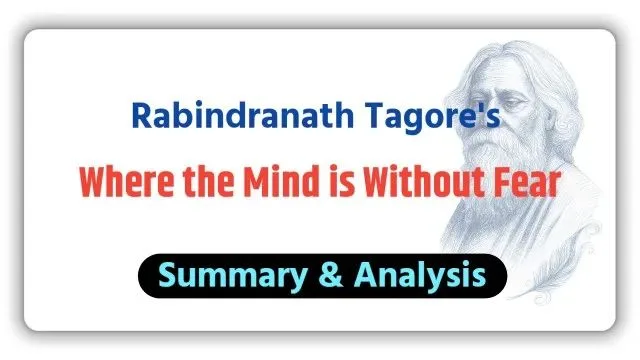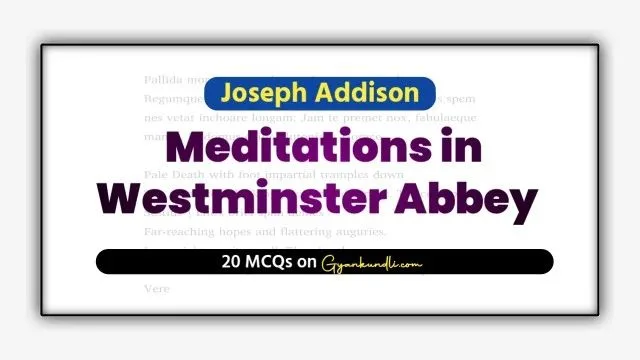Rabindranath Tagore’s famous poem Where the Mind is Without Fear was originally composed around 1900. It first appeared in his Bengali poetry collection Naibedya, under the title Prarthana (which means “Prayer”). Later, in 1911, Tagore himself translated it into English, and it was published as Poem 35 in Gitanjali by the Indian Society in London in 1912. In 1917, he recited its English version, then known as Indian Prayer, at the session of the Indian National Congress in Calcutta.
The poem reflects Tagore’s vision of a free India during the time of British rule. It is not only a prayer to God but also a call for awakening the spirit of courage, truth, and unity among Indians. Through this prayer, Tagore dreams of a nation where people live without fear, where knowledge is free, where truth prevails, and where the mind is led forward by God into ever-widening thought and action. This poem gave moral strength and inspiration to freedom fighters and became a guiding light in India’s struggle for independence.
About the Poet Rabindranath Tagore
Rabindranath Tagore, lovingly called Gurudev, was one of the greatest thinkers, poets, and artists of India. He transformed Bengali literature, music, and art during the 19th and early 20th centuries. In 1913, he became the first non-European writer to win the Nobel Prize in Literature for his famous collection of poems Gitanjali (Song Offerings).
Tagore introduced new styles in prose and poetry and made Bengali literature more natural and simple by using everyday language instead of the old classical Sanskrit style. He worked to bring the best of Indian culture to the West and also introduced Western ideas to India. He is widely respected as the most creative literary artist of modern India.
Though he mostly wrote in Bengali, Tagore translated many of his works into English, which made him famous across the world. Some of his most important works are Gitanjali, Gora (Fair-Faced), and Ghare-Baire (The Home and the World). His writings are admired for their deep thoughts, lyrical beauty, and simplicity.
Tagore also founded Visva-Bharati University, which became a centre of learning and culture, and still reflects his rich legacy. His works include poems, novels, short stories, essays, songs, and dance dramas, which often deal with both political and personal issues.
He composed the national anthems of two countries—Jana Gana Mana of India and Amar Shonar Bangla of Bangladesh. In 1915, the British Crown honoured him with a knighthood, but he gave it back in 1919 to protest against the Jallianwala Bagh massacre.
Even today, Tagore’s views on education, culture, poverty, gender equality, and freedom remain relevant in the 21st century.
About the Poem Where the Mind is Without Fear
The poem was written during the time when India was under British rule. In it, Rabindranath Tagore dreams of a nation where people enjoy freedom of mind, spirit, and action. His words awaken a deep sense of patriotism among readers. By praying for true freedom in education, work, and thought, the poem reflects the sad reality of the country then—enslaved, divided by caste and creed, burdened with superstitions, and trapped in prejudice.
Through this prayer, the poet appeals for a nation that becomes a “heaven of freedom”, a place that inspires everyone to rise above narrow divisions. The message of the poem is timeless; even today it reminds us of the importance of dignity, equality, and freedom of spirit.
Tagore’s vision is clear—he wishes for a country where:
- People live without fear and with honour.
- Knowledge is free for all, without restrictions.
- Society is not broken into narrow walls of caste, class, colour, or religion.
- Truth and honesty guide the people.
- Hard work and dedication lead to perfection.
- Minds are free from bad habits and low thoughts, moving only towards noble ideas.
In the end, the poet prays to God to guide his country into the heaven of freedom, where every citizen can live with dignity and peace.
Text of Where the Mind is Without Fear
Where the mind is without fear and the head is held high
Where knowledge is free
Where the world has not been broken up into fragments
By narrow domestic walls
Where words come out from the depth of truth
Where tireless striving stretches its arms towards perfection
Where the clear stream of reason has not lost its way
Into the dreary desert sand of dead habit
Where the mind is led forward by Thee
Into ever-widening thought and action
Into that heaven of freedom, my Father, let my country awake.
Form, Meter and Rhyme Scheme of Rabindranath Tagore’s Where the Mind Is Without Fear
Form of Where the Mind is Without Fear
The poem is written as a single stanza prayer addressed to God (the poet calls God “Father”). It lists the poet’s wishes for his country in a series of “Where…” statements and finishes with a direct appeal: “Into that heaven of freedom, my Father, let my country awake.” This makes the poem both devotional and didactic — it instructs and inspires.
Structurally it reads like a prose-poem / free-verse prayer: short lines, simple syntax, and a steady build of ideas rather than formal stanzas or refrains. The repeated beginning word “Where” (anaphora) gives unity and musical rise to the petition.
Meter of Where the Mind is Without Fear
There is no regular metrical pattern (no fixed number of syllables or repeated stress pattern). The rhythm is natural and speech-like, following the flow of thought more than a strict beat. Because of this, readers often call it free verse. Examples: the line “Where the mind is without fear and the head is held high” is longer and flowing, while “Where knowledge is free” is short and emphatic — showing irregular line lengths and rhythm.
Rhyme Scheme of Where the Mind is Without Fear
The poem does not follow a rhyme scheme. Lines do not end in matching sounds in any regular pattern. Tagore chooses meaning and moral urgency over rhyming effects, so the poem’s power comes from idea, repetition, and imagery rather than rhyme. In short: no set rhyme scheme — free verse.
Summary of Where the Mind is Without Fear
In this poem, Rabindranath Tagore presents his dream of the kind of India he wishes to see. In the beginning, he prays to God for a country where people live without fear or oppression, and where everyone can hold their heads high with dignity. He imagines a nation where education is free for all, not limited to any caste, class, or gender, but open to every individual.
Tagore strongly wishes for a society that is not broken into small fragments by caste, creed, religion, colour, or blind superstitions. He dreams of people who always speak the truth and whose words come from the depth of honesty. He also desires a nation where citizens work hard and tirelessly to achieve perfection, leaving behind narrow prejudices and outdated traditions.
The poet further prays that the power of reason should guide the minds of his countrymen, instead of being trapped by old customs that weaken progress. Only when people follow reason can they move towards noble thoughts and meaningful actions.
Finally, Tagore addresses God as the “Father” and appeals to Him to awaken India into a heaven of freedom, where truth, dignity, knowledge, and unity prevail.
Analysis of Where the Mind is Without Fear
Rabindranath Tagore’s poem Where the Mind is Without Fear is one of the most inspiring poems of modern Indian literature. Written during the time of British rule, it expresses the poet’s vision of a free and ideal India. The poem is both a prayer to God and a dream for the nation’s future.
Theme
The central theme of the poem is freedom in its truest sense. Tagore prays for a country where people can live without fear, where they can hold their heads high with dignity, and where knowledge is freely available to all. He dreams of a society free from divisions of caste, class, religion, and superstition.
Patriotism
The poem reflects Tagore’s deep patriotic feelings. At a time when India was struggling under British rule, he gave the people a vision of a nation where truth, honesty, and hard work guide the citizens. His prayer was not just for political freedom, but also for mental, moral, and spiritual freedom.
Moral and Social Values
Tagore stresses the importance of truthfulness, sincerity, reason, and unity. He criticises blind faith, outdated traditions, and narrow prejudices that divide society. For him, true progress can come only when people work tirelessly, guided by reason and noble thoughts.
Imagery and Symbolism
The poem uses simple yet powerful imagery. For example:
- “Head is held high” stands for dignity and self-respect.
- “Narrow domestic walls” symbolise divisions of caste, religion, and class.
- “Clear stream of reason” suggests rational thinking.
- “Dreary desert sand of dead habit” represents blind traditions and meaningless customs.
These images make the poem universal, relevant not only to India but also to the whole world.
Tone and Style
The tone of the poem is prayerful, earnest, and uplifting. It is written in free verse, without rhyme or regular meter, which makes it sound like a natural conversation with God. The repetition of the word “Where” at the beginning of many lines gives rhythm and emphasis.
Universal Message
Though written during the struggle for Indian independence, the poem carries a universal message. Every country, every society can relate to the poet’s vision of a world free from fear, ignorance, and prejudice. That is why the poem remains relevant even today.
Discover more from Gyankundli
Subscribe to get the latest posts sent to your email.











